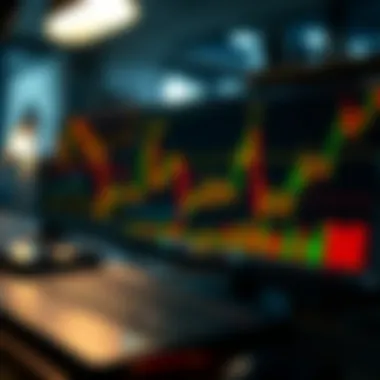Best Free Crypto Trading Charts for Smart Traders


Intro
In the fast-paced world of cryptocurrency trading, having access to reliable and insightful information is paramount. As traders navigate through the ups and downs of the market, the need for effective tools to analyze trends and make informed decisions becomes increasingly critical. This is where free crypto trading charts come into play. They serve as a fundamental resource for investors, analysts, and enthusiasts alike, allowing them to visualize market data in an accessible manner.
This guide sheds light on various platforms and tools that offer free crypto trading charts, helping users decode the myriad features essential for successful trading. Whether you're a newcomer trying to make sense of price fluctuations or an experienced trader seeking to refine your strategies, understanding how to interpret and utilize these charts can significantly impact your trading outcomes.
Through a straightforward exploration of key concepts, trading strategies, and practical applications, this article aims to equip you with the insights needed to navigate the crypto landscape effectively.
Let’s dive into the fundamental aspects of cryptocurrency trading charts that every trader should grasp to enhance their trading acumen.
Understanding Crypto Trading Charts
Crypto trading charts serve as a vital compass for traders, guiding them through the complex seas of cryptocurrency markets. The sheer volatility of digital currencies often leaves investors questioning their decisions, making effective charting an essential tool in their trading toolkit. By comprehending how to read and interpret these charts, traders can gain valuable insights into market trends, price movements, and overall sentiment. This not only aids in informed decision-making but helps in devising robust trading strategies to navigate the unpredictable nature of crypto trading.
What Are Crypto Trading Charts?
Crypto trading charts visually represent price movements and trading volume over time. They are similar to the charts one might find in traditional stock markets but are tailored to showcase the nuances of the digital currency landscape. Typically, these charts plot prices on the vertical axis against time on the horizontal axis, allowing traders to see trends depending on the period they’re interested in, be it hours, days, or months.
In essence, these charts can take various forms, the most common being line charts, bar charts, and candlestick charts. Each type offers different layers of information:
- Line Charts: Simple graphs showing the price movement over time, providing a clear view of trends.
- Bar Charts: More detailed than line charts, showing opening, closing, high, and low prices within a timeframe.
- Candlestick Charts: These are popular in crypto trading; they depict price movements through colored “candles,” visually conveying buying and selling pressure within specific time frames.
Each of these formats helps traders understand not just where the market has been, but where it might head, providing the backbone for predictive analysis.
Importance of Technical Analysis
Technical analysis is crucial for traders looking to optimize their strategies. At its core, this method focuses on historical price data to predict future movements. Unlike fundamental analysis, which looks at economic factors affecting a market, technical analysis relies almost solely on chart patterns and market behavior.
The crux of technical analysis lies in the belief that prices move according to the laws of supply and demand. By examining historical data, traders can identify patterns that may repeat, allowing them to anticipate potential price movements. Here are key aspects of technical analysis that users should consider:
- Indicators and Oscillators: Tools like Moving Averages or the Relative Strength Index (RSI) can help confirm trends or signal divergences.
- Support and Resistance Levels: Recognizing these levels can arm traders with insights into possible entry and exit points.
- Chart Patterns: Familiarity with patterns such as head and shoulders or triangles allows traders to gauge potential trend reversals or continuations.
The importance of mastering technical analysis cannot be overstated—it’s often the difference between a successful trade and a costly mistake. Investors who enhance their understanding of various indicators and market signals increase their odds of making strategic moves in an otherwise unpredictable trading environment.
In crypto trading, knowledge of technical analysis transforms a trader from mere speculation to informed decision-making, honing one's instinct over time.
Features of Effective Trading Charts
When navigating the often tumultuous waters of crypto trading, effective charts are like sturdy ships that help investors chart a course. The features of these trading charts are not only important but also pivotal in shaping a trader's decisions. A well-designed chart can turn a novice into a savvy participant in the market, ultimately guiding their trades to success. Features such as real-time data, customizable indicators, and a user-friendly interface empower traders to analyze price movements, assess market trends, and develop strategies that align with their trading goals.
Real-Time Data
In the ever-changing world of cryptocurrencies, timing is everything. Real-time data is the cornerstone of an effective trading chart. It allows traders to see the latest price movements, which is crucial for making timely decisions. A chart that doesn’t offer updated information can lead to missed opportunities or, worse, financial losses.
Having real-time updates can be compared to driving with a GPS that gives turn-by-turn directions; without it, you'd be guessing your way through unknown territory. Traders need precise data to understand market volatility. Many platforms provide high-resolution charts that display bid-ask spreads, volume changes, and other metrics, allowing traders to react quickly to market shifts and adjust their strategies accordingly.
"The market is a living organism; in order to understand it, you must be in sync with its pulse."
Keeping your finger on the pulse is critical, especially in a 24/7 market like cryptocurrency. This data must be accurate not just to get a sense of direction but to make trades that are worth your while.
Customizable Indicators
Every trader has their own flavor, and customizable indicators let them spice up their charts to suit their trading style. These indicators can range from moving averages to Bollinger Bands, giving traders the flexibility to apply metrics that resonate with their strategies. For instance, a day trader might prefer a combination of short-term indicators, while a long-term investor might lean towards fundamental growth metrics.
The ability to tweak these indicators also allows traders to backtest their strategies. Before diving into real trades, they can see how their chosen indicators would have performed historically. It’s like trying on a suit before buying; you wouldn't want to walk out in something that looks awful, right?
This customization is often supported by platforms that allow you to save your settings, so you don’t need to reinvent the wheel every time you sit down to chart. With just a few clicks, you can identify trends and make informed decisions based on analyses tailored to your individual trading style.
User-Friendly Interface
A smooth interface can make or break the user experience when utilizing trading charts. Complex designs might intimidate novice traders, scaring them away from important tools they need to succeed. A user-friendly interface streamlines navigation and enhances the overall experience. Key features like drag-and-drop functionality for indicators, zoom options for different time frames, and easy-to-read legends make the learning curve less steep.
Intuitive layouts can help even the most inexperienced traders pick up the basics without feeling overwhelmed. Think of it as walking into a restaurant with a menu that makes ordering your favorite food a breeze instead of trying to decipher a confusing jumble of options.
Comparative Analysis of Free Crypto Trading Platforms
When navigating the complex world of cryptocurrencies, having access to the right trading platform can be the difference between a profitable trade and losses that keep you up at night. This section shines a light on the comparative analysis of free crypto trading platforms, emphasizing their roles in providing traders with crucial insights. Every platform comes with its own set of features, pros and cons, and user experiences that can significantly influence trading decisions. Understanding these nuances is essential for any trader wishing to leverage the best tools available without breaking the bank.


Popular Platforms Overview
In the vast ocean of crypto trading platforms, a few names stand out for offering free charting tools that cater to both beginners and seasoned investors. Here are a few of the most commonly used platforms today:
- TradingView: Known for its wide range of indicators and community-driven insights, it offers a user-friendly interface that encourages traders to share and explore different strategies.
- Coinigy: Combining data from various exchanges into one interface, this tool streamlines tracking and trading, though certain features may require a paid plan.
- CryptoCompare: This platform offers comprehensive analytics on price trends and historical data while being user-centric, making it a good option for novice traders.
These platforms make it easier to visualize market movements and analyze data, which is vital for informed trading.
Strengths and Weaknesses
Examining the strengths and weaknesses of these platforms helps to formulate a clearer picture of what traders can expect. Here's a breakdown that might offer some clarity:
- TradingView
Strengths: - Coinigy
Strengths: - CryptoCompare
Strengths:
- Extensive library of technical indicators
- Active community and social features
- Custom script functionalities
Weaknesses: - Free version has limited features compared to premium plans
- Occasional slow response times during peak trading hours
- Integrated exchange functionalities
- Access to multiple exchanges from a single interface
Weaknesses: - Main features are behind a paywall
- Learning curve can be steep for newcomers
- Easy navigation for users of all levels
- In-depth comparisons of cryptocurrencies
Weaknesses: - Limited real-time data updates
- Fewer interactive features than competitors
This analysis provides a groundwork for traders to assess which platform aligns best with their trading style and requirements.
User Experiences and Ratings
User experiences and feedback can significantly enrich our understanding of these platforms. Each user brings their own perspective, contributing to a tapestry of reviews that reveals the on-the-ground performance of the charts.
- TradingView is often lauded for its robust community-driven content, where users frequently report high satisfaction levels. Many traders appreciate the interactivity and ease of developing customized charts.
- Meanwhile, Coinigy receives mixed reviews, with some users praising its actionable insights while others highlight frustrations regarding subscription costs. User ratings often lean towards the positive but signal that new traders might struggle with the interface's intricacy.
- CryptoCompare finds a niche among preliminary traders who value simplicity. Users frequently comment on its straightforward layout, although some wish for more advanced features that are commonplace in premium tools.
"Ultimately, the best platform for you will depend on your trading needs, preferences, and the specific tools you feel most comfortable using."
Top Free Crypto Trading Chart Tools
When delving into the world of cryptocurrency trading, the role of effective chart tools cannot be overlooked. These tools serve as the compass guiding traders through the choppy waters of the market. They deliver crucial insights that drive decision-making, allowing traders to strategize based on real-time data and analytical patterns. With a plethora of free options available, knowing which tools are worth the time can make a world of difference.
To navigate this landscape, we will examine several standout free crypto trading chart tools, offering an overview of their key features, user interface, and the best scenarios for their use. Each tool brings its own flavor and strengths to the table.
Tool One: TradingView
Overview: TradingView stands out as a highly regarded platform for trading chart analysis. It's like a Swiss army knife for traders, combining simplicity with powerful tools that satisfy both beginners and experienced traders alike.
Key Features
TradingView is known for its robust capabilities. Notable features include coordinated market analysis that spans multiple asset classes, extensive chart customization options, and a thriving community sharing insights. Its flexibility in indicators and drawing tools helps tailor the experience, allowing traders to build their unique setups for strategies. The huge variety of available indicators makes it a go-to for those who fawn over technical analysis.
User Interface
The user interface of TradingView is stylish yet functional. With its drag-and-drop layout, users can easily organize their workspace to cater to their specific preferences. A unique aspect is the social networking element integrated into the platform; users can publish ideas or trade insights, thus engaging with a larger community. Although the wealth of information may seem overwhelming for newcomers, once they find their footing, it becomes a goldmine of resources.
Best Use Cases
TradingView is particularly beneficial for day traders and those focused on real-time data. The live streaming of price movements allows traders to make quick decisions based on market fluctuations. Additionally, the ability to set alerts for price levels is an advantageous feature for preventing missed opportunities. Its charting tools are suitable for any trading style, whether one seeks to ride short-term waves or set up for long-term holds.
Tool Two: Coinigy
Overview: Coinigy provides a comprehensive trading experience by marrying charting capabilities with portfolio management. With its multi-exchange integration, it becomes a refreshing platform for cryptocurrency enthusiasts managing assets across various venues.
Key Features
One of Coinigy's standout features is the integrated trading functionality that allows users to execute orders directly from the charts. Adding automated trading tools that can access multiple exchanges streamlines the whole trading process. This integration not only simplifies management but also reduces the chances a trader ends up juggling too many platforms.
User Interface
The user interface on Coinigy leans towards a more traditional design compared to some newer platforms. While it may not win beauty contests, its straightforward layout provides clarity. Traders can find everything they need without getting lost in unnecessary complexities. However, the more seasoned user might find the simplicity both a blessing and a bane at times.
Best Use Cases
Coinigy shines for traders who operate in multiple cryptocurrency markets. It’s ideal for users who need to keep a close watch on diversified assets and execute trades efficiently without hopping from one platform to another. Those who prioritize a hands-on trading experience might find its features quite handy.


Tool Three: CryptoCompare
Overview: CryptoCompare focuses more on providing detailed market data than charting alone. This tool aggregates data from various exchanges, giving traders a broad view of the market dynamics.
Key Features
CryptoCompare excels in its data aggregation functionalities, offering users the ability to compare cryptocurrencies across price, volume, and more. The site also displays a plethora of market insights, making it easy for traders to gauge market sentiment. Its unique selling point is the availability of numerous coins, providing insights for lesser-known assets as well.
User Interface
The user interface is structured yet minimalistic, making navigation easy. There’s somewhat of a learning curve as users dive into the data-rich environment. However, the wealth of information can be overwhelming at first glance. Once users begin filtering through the available data, they often find its treasure trove more useful than they originally anticipated.
Best Use Cases
CryptoCompare is perfect for analytical traders, especially those who enjoy digging deep into market data. By leveraging the comprehensive analytics for price movements, traders can unearth valuable patterns. It also suits users aiming to explore niche cryptocurrencies rather than dominant players in the field.
"Having the right information at your fingertips can be the difference between a successful trade and a costly mistake."
As the crypto market evolves, so too will the tools we use. It's essential to stay updated on the available options and continuously assess what best suits your trading style.
Advanced Charting Techniques
In the fast-paced world of crypto trading, understanding advanced charting techniques can be a game changer. While basic charts offer traading insights, advanced techniques provide deeper analysis that can significantly enhance your strategy. By delving into elements like candlestick patterns, Fibonacci retracement, and Bollinger bands, traders can learn to anticipate market movements more accurately. It's not just about the numbers; it's about discerning patterns that indicate potential price changes. Here, we will dissect these tools and how they lead to more informed trading decisions.
Understanding Candlestick Patterns
Candlestick patterns are a cornerstone of technical analysis in trading. Each candlestick provides crucial information about price action during a specific time period. The body of the candlestick shows the opening and closing prices, while the wicks or shadows indicate the highest and lowest prices during that timeframe.
Why are they important?
These patterns help traders identify market sentiment and continuation or reversal signals. Some common patterns include:
- Doji: Indicates indecision in the market, signaling potential reversals.
- Hammer: Often signifies a potential bullish reversal following a downtrend.
- Engulfing Pattern: Shows a clear shift in momentum; a bullish engulfing can mean buyers are taking control.
"Understanding these patterns is like reading the market’s emotions. When you know what they say, you’re several steps ahead in the game."
Traders who master candlestick patterns can enhance their decision-making and timing, turning a simple graph into a roadmap of potential market movements.
Using Fibonacci Retracement
Fibonacci retracement is another powerful tool in the trader's arsenal, enabling them to identify potential support and resistance levels within a price trend. The concept is based on the Fibonacci sequence, where each number is the sum of the two preceding ones, leading to ratios like 23.6%, 38.2%, 50%, 61.8%, and 100%.
How to implement it?
- Draw the Fibonacci retracement tool from the recent high to low (or vice-versa) on your chart.
- The retracement levels indicate where prices might pull back before continuing in the original direction.
Understanding these levels allows for better strategic planning of entry and exit points, especially during a volatile market such as cryptocurrency.
Bollinger Bands and Moving Averages
Bollinger Bands and moving averages complement each other, making them a dynamic duo for traders looking to gauge volatility. The concept behind Bollinger Bands is simple: they consist of a middle band (the moving average) and two outer bands which are typically set two standard deviations away from this average.
Why are they beneficial?
- Volatility Measurement: A tightening of the bands often indicates that a breakout might be on the horizon.
- Buy/Sell Signals: When the price touches the upper band, it might indicate that the asset is overbought, while touching the lower band could mean it's oversold.
Moving averages, on the other hand, help smooth out price action over a specific period, providing insights into the overall trend. A common practice is to look for crossovers between different moving averages, such as the 50-day and 200-day moving average, to determine potential buy or sell signals.
In essence, combining Bollinger Bands with moving averages allows traders to assess market conditions comprehensively, making it easier to identify profitable trading opportunities.
Integrating Trading Charts with Decision-Making
Integrating trading charts into your decision-making process is pivotal for anyone navigating the turbulent waters of cryptocurrency trading. Without a clear understanding of the data represented in these charts, traders risk relying on gut feelings or hearsay, methods that often lead to poor outcomes. Rather, harmonizing your analysis with chart insights turns subjective choices into informed selections, allowing for maximizing potential returns.
One major advantage of using trading charts is the ability to identify patterns. The past often holds clues about future price movements, and recognizing trends can be the difference between hitting it big or missing the boat entirely. For instance, utilizing candlestick patterns can provide visual signals that signify possible market reversals or continuations. However, this is just the tip of the iceberg.
Key Elements to Consider:


- Historical Context: Charts offer a glimpse into historical data, allowing traders to comprehend long-term trends.
- Volatility Analysis: Assess the fluctuation in asset prices. A sudden spike might warrant close observation before making a decision.
- Indicator Correlation: Combine multiple indicators and charts for a well-rounded view. Relying on a single source can cloud your judgment.
Though turning charts into actionable decisions isn’t foolproof, taking this approach cultivates habits that favor logical thought over emotional instincts. Thus, a seasoned trader doesn’t just look at a chart; they interpret and integrate it into their overarching strategy.
Developing a Trading Strategy
Creating a robust trading strategy is like crafting a recipe; it requires the right ingredients combined in perfect ratios. In the context of crypto trading, that means using charts not just to track prices but as essential tools to develop your strategy.
A successful trading strategy should take into account your risk tolerance, market conditions, and investment goals. First, define your objectives. Are you looking to invest long-term or are you more inclined toward day trading? Your choice of charts will significantly depend on this.
- Set your timeframes: Different charts serve various trading styles. For short-term trades, one might lean on hourly charts, while for longer holds, daily or weekly charts would likely be more appropriate.
- Select indicators: Identify which indicators you will employ. For example, Moving Averages can help identify trends, while Relative Strength Index (RSI) could provide insight into whether an asset is overbought or oversold.
Putting it into Action:
- Analyze past performance using selected indicators.
- Simulate trading through demo accounts to refine your strategy without financial risk.
- Make adjustments based on outcomes and evolving market conditions.
Setting Entry and Exit Points
Determining where to enter a position is just as crucial as knowing when to pull the trigger to exit. The right entry and exit points can amplify your profits and reduce losses. This is where trading charts play a vital role as they help map the ideal points based on statistical analysis and market movements.
Key considerations for setting entry and exit points include:
- Support and Resistance Levels: Recognizing these levels through historical price data can significantly bolster your decision. A strong support level might offer an ideal entry, while resistance levels might signal a time to exit or adjust your position.
- Stop-Loss Orders: Utilize these to minimize potential losses. By having a clear stop-loss in place based on chart indicators or price levels, you can protect yourself from significant downturns.
- Profit Targets: Just as important as knowing when to exit a losing position is understanding when to take profits. Setting realistic profit targets based on historical price movements can ensure you don’t hang onto a position too long due to greed.
Integrating these elements creates a disciplined approach that limits emotional trading. Relying on technical analysis, supported by chart data, contributes to a more systematic method of investing.
"The best traders don’t just make decisions; they make informed choices rooted in analysis and strategy."
Common Mistakes in Using Trading Charts
When navigating the complex waters of crypto trading, relying on charts is just par for the course. Yet, as various traders dive into their kaleidoscope of candlesticks and moving averages, many find themselves caught up in blunders that can turn potential profits into pesky losses. Understanding these common pitfalls not only enhances your trading acumen but also can save both time and money. Here, we look at two prevalent mistakes: overreliance on indicators and ignoring market trends.
Overreliance on Indicators
Indicators can sometimes feel like a trader's best friends; they flash signals and provide insights to help steer decisions. However, it’s easy to become overly dependent on these tools.
Remember: Too many indicators can cloud your judgment rather than clarify it.
Indicators offer projections based on historical data, yet past performance is not always a clear mirror of current conditions. For instance, imagine a trader who's fixated on the RSI or MACD without considering external market shifts. This can lead to decisions based on outdated patterns, ultimately resulting in missed opportunities or unfortunate losses.
Instead of treating indicators as gospel, it's wiser to use them as one piece in a broader puzzle. Combining indicators with fundamental analysis can provide a more balanced view. This means also keeping your ear to the ground about news and events that might shake or uplift the market.
Ignoring Market Trends
One of the biggest oversights is completely overlooking the overarching market trends. Think of the cryptocurrency market like a river; if you row upstream against a current, you're bound to get tired out and end up going no where fast. Ignoring whether the market is in an uptrend or downtrend can be detrimental to your strategy.
When a market is trending up, it doesn’t make much sense to jump in selling — that’s just begging for a loss. Conversely, if the trend is down, diving in to buy without a strategy can lead to regrettable decisions.
Investors should always take the time to identify prevailing trends before making transactions. Utilizing tools like trend lines and moving averages can help spot these patterns more reliably. Being aware of the general market mood can make the difference between success and failure.
In summary, avoiding these common mistakes—overreliance on indicators and disregarding market trends—will equip traders with a more solid foundation. The landscape of trading can be ever-changing, but awareness and adjustment can lead to more informed decisions.
Culmination: Maximizing Chart Utility in Crypto Trading
In the ever-evolving landscape of cryptocurrency trading, the role of effective trading charts cannot be overstated. This section serves as a rallying call for traders, investors, and anyone keen on navigating the complexities of the crypto market to harness the full potential of these invaluable tools. As we’ve explored throughout this guide, effective charting is not merely about observing price movements; it’s about drawing insights, making informed decisions, and ultimately developing a robust trading strategy.
Importance of Recognizing Chart Utility
When traders understand how to leverage charts effectively, they unlock a realm of possibilities. Charts can serve as a lens, magnifying patterns and trends that may not be immediately obvious at first glance. For instance, recognizing resistance and support levels can significantly influence buying and selling decisions. Ignoring these elements can lead to missed opportunities or, worse, financial losses.
"Charts tell a story; it's up to the trader to read between the lines."
This perspective speaks volumes about the necessity of honing one’s chart-reading skills. Investors should approach charts not just as a visual representation of data but as a narrative about market sentiment. A trader who can interpret candlestick formations or Fibonacci levels has the upper hand in making strategic decisions.
Strategic Benefits of Chart Usage
One major advantage of using trading charts is the real-time data they provide. Immediate access to market fluctuations enables traders to adapt swiftly. Here are a few benefits of chart utilization to consider:
- Decision-Making Speed: Real-time insights allow for quicker actions during market volatility, an essential aspect in a market known for its rapid swings.
- Risk Management: Understanding indicators like Bollinger Bands can help traders set effective stop-loss orders, which are crucial for protecting one’s investment.
- Comprehensive Analysis: The integration of customizable indicators enables users to tailor their charts to fit personal trading strategies, further enhancing analytical precision.
Considerations in Chart Usage
However, it’s also vital to tread carefully. Over-reliance on charts without a comprehensive market understanding can lead to pitfalls. Here are a few points to keep in mind:
- Avoiding Confirmation Bias: Traders might be tempted to see what they want to see. This can cloud judgment, making it essential to keep an open mind and consider multiple data points.
- Market Sentiment: Charts do not exist in a vacuum; external factors can sway price movements drastically. Remaining aware of news and trends outside of what is visible on the charts is key.
- Education and Practice: Continuous learning is important. Markets evolve, and so should a trader’s approach to chart analysis.
In summary, maximizing the utility of crypto trading charts hinges on understanding their strengths, adapting to market dynamics, and combining them with sound trading principles. By integrating effective charting strategies into their routine, traders not only enhance their analytical capabilities but also build a solid foundation for long-term success in the elusive cryptocurrency realm.















